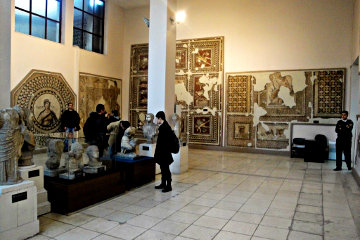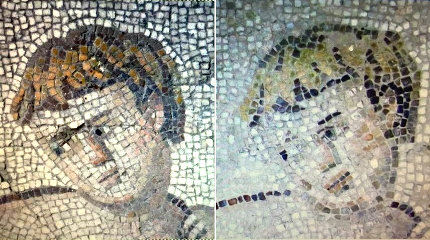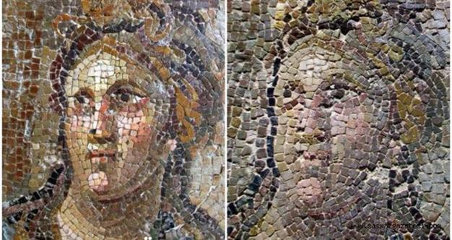Mangled Mosaics

| |
| The Ecce Homo before and after Senora Gomez took it in hand. |
A year or so ago there was much hilarity caused by an unfortunate Spanish woman whose artistic amibitions exceeded her abilities by a considerable margin. There was a fresco in her local church which had been damaged by time, damp and carelessness, the common enemies of such paintings. The priest enquired about having the painting restored, gulped when he learned the price, and turned to a member of his congregation, Cecilia Gomez, who wielded a nifty brush.
Unfortunately Senora Gomez was 80 years old and her best painting days were behind her, a fact that neither she nor anyone else recognised until the priest came to check how the work was progressing and discovered that a mildly damaged artwork, beloved by the community, had been turned into something that bore only the vaguest of resemblances to a human figure.
Even more unfortunately, to restore the art work to its original condition would cost even more than the initial quote, but every cloud has a silver lining. Senora Cecilia's apalling artwork has become something of a tourist sensation and the Church of the Sanctuary of Mercy near Zaragoza has started to charge admission and is making quite a good thing out of it. Perhaps one day they will be able to afford a proper restoration!
Alas, Cecilia Gomez is not the only one to overestimate her powers, nor is painting the only medium in which the over-confident can come a cropper. A local whistle-blower has recently called time on a project to restore mosaics in the Hatay Archaeological Museum in Antakya, Turkey - the Antioch where the followers of Jesus were first called "Christians". The museum is famous for its mosaics, many of which were recovered from the Roman villas which lined the Orontes River and the Gardens of Daphne.

| |
| Visitors admire some of the mosaics in the old Hatay Archaeological Musem under the watchful eye of a guard - but quis custodiet ipsos custodes? |
The Gardens of Daphne were a sort of combination of Las Vegas, Disney World, and the Moulin Rouge, world-renowed for the beauty of their setting and the astonishing array of fleshly pleasures on offer to visitors. People flocked to Antioch from all over the known world and when some of the citizens became entangled in a somewhat puritanical Jewish sect it was no wonder that their more earthly compatriots lost no time in devising a mocking nick-name for them.
In December 2014 the Hatay Museum, the second-largest mosaic museum in the world, opened a new building, in which 54,000 square feet would be devoted to displaying the wealth of mosaics in their storerooms. Whether time and neglect caused some of the stones to fall out of the mosaics or whether they were damaged in the move, has not been revealed. What we do know is that someone from the museum decided to economise by sticking the bits back together himself.

| |
| Mosaic of a boy from the Hatay Archaeological Museum. Note the heavy line on the right of the boy's neck which was not there before the "restorers" got at it! |
We have already reported on an attempt at economy by the Cairo Museum, where a curator stuck Tutankhamun's beard on again with Araldite (or similar epoxy resin) with unfortunate results - and, of course, there is always Senora Gomez, the patron saint of misguided restoration. Hatay Museum provides the third example of the folly of Do-It-Yourself art restoration.
It would appear that the person responsible in Antakya found himself faced with a handful or two of tiny cubes of coloured stone and, having the artisitic sensibility of the grey-coated quadruped that is the common beast of burden in the Middle East, he selected cubes at random and stuck them back in the plaster as the fancy took him. The result is so apalling that some who viewed the photographs taken by Mehmet Daskapan, the whistle-blower, suggested that he had Photoshopped the pictures in pursuit of some sort of vendetta against the museum authorities. Others have pointed out that the regional governor has ordered the brand-new mosaic museum to close until further notice, which would seem to indicate that there are grounds for Mr Daskapan's concerns.
Mehmet Daskapan is himself a mosaic craftsman, which explains how he was able to acquire "before" and "after" photographs of the ten mosaics which had been botched. The team responsible for the restoration have hit back, claiming that the damage is all the fault of French restorers back in the 1930s. According to their statement, the French replaced missing stones with painted plaster or stone and then varnished the whole mosaic, thus accounting for the deeper colours in the "before" pictures.

| |
| A botched mosaic from the Hatay Archaeological Museum; the picture on the left shows how the French left it, on the right how it appears after the latest "restoration". |
It is certainly true that the colours in ancient mosaics are usually dull and guards hoping for a tip will often keep a bucket of water nearby which they pour over the mosaic to enhance the colours for tourists. Nevertheless I do not believe that the lack of varnish nor the removal of painted plaster can account for the damage and distortion seen in Mr Daskapan's photographs. As someone who frequently uses Photoshop (or rather, its free alternative, The Gimp) I have to say that the damage does not bear any hallmarks of digital manipulation.
The Culture Ministry has formed a commission to look into the matter and work on the remaining mosaics has been suspended until the commission reports. Quite apart from any artistic considerations, the locals have another worry. "This is a massacre of history that may even affect the number of tourists who will visit Hatay," moaned Sefik Cirkin, an opposition politician.
I think he is right to be worried. Mrs Gomez' atrocity may form an attraction for the thousands of bored sun-seekers in Spain with nothing else to do while they are in the area, but Antakya is not so flush with tourists that it can afford to alienate any of them. Already tourism in the area has fallen due to security concerns over the presence of ISIS fanatics just the other side of the border (a concern that has not been helped by Turkey's curious reluctance to come out in opposition to ISIS during the siege of Kobane). The least hint that the world-famous mosaics have been ruined and tourism may well drop to zero.
On the whole, the Turks could do worse than invite the French back again.
© Kendall K. Down 2015





